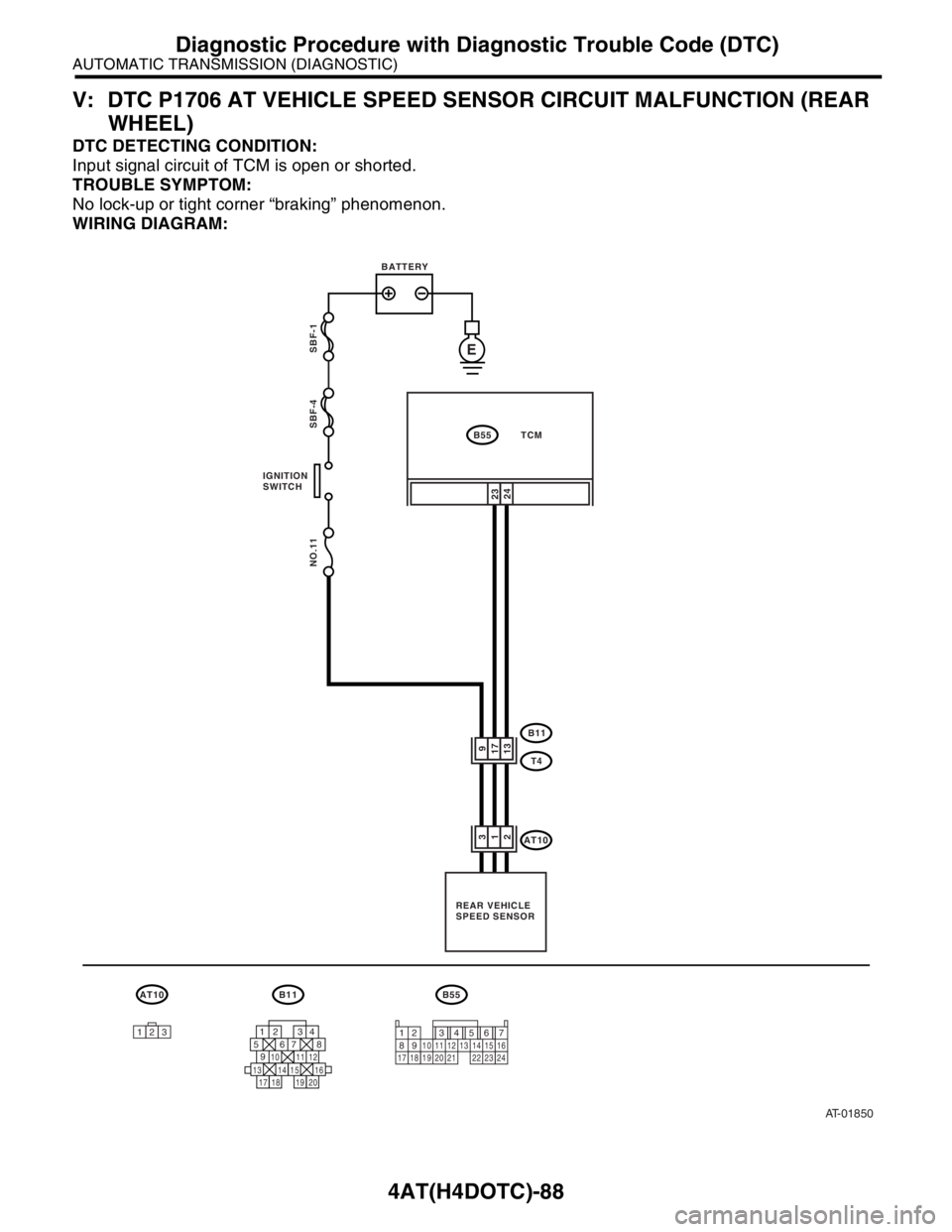2004 SUBARU FORESTER wheel
[x] Cancel search: wheelPage 2656 of 2870

4AT(H4DOTC)-80
AUTOMATIC TRANSMISSION (DIAGNOSTIC)
Diagnostic Procedure with Diagnostic Trouble Code (DTC)
5 CHECK OUTPUT SIGNAL FROM TCM.
1) Connect the connectors to TCM and trans-
mission.
2) Lift-up the vehicle and place rigid racks.
N
OTE:
Raise all wheels off ground.
3) Start the engine and warm-up the engine
until ATF temperature is above 80°C (176°F).
N
OTE:
If ambient temperature is below 0°C (32°F),
drive the vehicle until ATF reaches its operating
temperature.
4) Shift the select lever to “D” range and
slowly increase vehicle speed and measure at
3rd or 4th gear.
N
OTE:
The speed difference between front and rear
wheels may light the ABS warning light, but this
indicates no malfunction. When AT control diag-
nosis is finished, perform the ABS memory
clearance procedure of on-board diagnostics
system.
5) Measure the voltage between TCM con-
nector and chassis ground.
Connector & terminal
(B56) No. 8 (+) — Chassis ground (
−):Is the voltage less than 1 V? Go to step 6.Go to step 9.
6 CHECK OUTPUT SIGNAL FROM TCM.
1) Return the engine to idling speed and shift
select lever to “N” range.
2) Measure the voltage between TCM con-
nector and chassis ground.
Connector & terminal
(B56) No. 8 (+) — Chassis ground (
−):Is the voltage more than 10.5
V?Even if the POWER
indicator light was
blinking, the circuit
has returned to a
normal condition at
this time. A tempo-
rary poor contact of
the connector or
harness may be the
cause. Repair the
harness or connec-
tor in TCM and
transmission.Go to step 9. Step Check Yes No
Page 2657 of 2870

4AT(H4DOTC)-81
AUTOMATIC TRANSMISSION (DIAGNOSTIC)
Diagnostic Procedure with Diagnostic Trouble Code (DTC)
7 CHECK OUTPUT SIGNAL FROM TCM US-
ING SUBARU SELECT MONITOR.
1) Connect the connectors to TCM and trans-
mission.
2) Lift-up the vehicle and place rigid racks.
N
OTE:
Raise all wheels off ground.
3) Connect the Subaru Select Monitor to data
link connector.
4) Start the engine and turn Subaru Select
Monitor switch to ON.
5) Start the engine and warm-up the engine
until ATF temperature is above 80°C (176°F).
N
OTE:
If ambient temperature is below 0°C (32°F),
drive the vehicle until ATF reaches its operating
temperature.
6) Read the data of high clutch duty solenoid
using Subaru Select Monitor.
High clutch duty solenoid is indicated in “%”.
7) Shift the select lever to “D” range and
slowly increase vehicle speed and measure at
3rd or 4th gear.
NOTE:
The speed difference between front and rear
wheels may light the ABS warning light, but this
indicates no malfunction. When AT control diag-
nosis is finished, perform the ABS memory
clearance procedure of on-board diagnostics
system.
8 CHECK OUTPUT SIGNAL FROM TCM US-
ING SUBARU SELECT MONITOR.
Return the engine to idling speed and shift
select lever to “N” range.
N
OTE:
The speed difference between front and rear
wheels may light the ABS warning light, but this
indicates no malfunction. When AT control diag-
nosis is finished, perform the ABS memory
clearance procedure of on-board diagnostics
system.
indicator light was
blinking, the circuit
has returned to a
normal condition at
this time. A tempo-
rary poor contact of
the connector or
harness may be the
cause. Repair the
harness or connec-
tor in TCM and
transmission.Go to step 9.
9 CHECK POOR CONTACT.Is there poor contact in high
clutch duty circuit?Repair poor con-
tact.Replace the TCM.
trol Module
(TCM).> Step Check Yes No
Page 2663 of 2870

4AT(H4DOTC)-87
AUTOMATIC TRANSMISSION (DIAGNOSTIC)
Diagnostic Procedure with Diagnostic Trouble Code (DTC)
2 CHECK HARNESS CONNECTOR BETWEEN
TCM AND N–R LOCK SOLENOID.
Measure the resistance of harness between
TCM and chassis ground.
Connector & terminal
(B56) No. 18 — Chassis ground:Is the resistance more than 1
MΩ?Go to step 3.Repair the short
circuit in harness
between TCM and
N–R lock solenoid
connector.
3 CHECK HARNESS CONNECTOR BETWEEN
N–R LOCK SOLENOID AND CHASSIS
GROUND.
Measure the resistance of harness between
N–R lock solenoid and chassis ground.
Connector & terminal
(B117) No. 5 — Chassis ground:Is the resistance less than 1
Ω?Go to step 4.Repair the open
circuit in harness
between chassis
ground terminal
and N–R lock sole-
noid connector.
4 CHECK N–R LOCK SOLENOID.
Measure the resistance between N–R lock
solenoid.
Connector & terminal
(B117) No. 5 — No. 4:Is the resistance 20 — 40 Ω? Go to step 5.Replace the N–R
lock solenoid.
5 CHECK TCM OUTPUT SIGNAL.
1) Connect all connectors.
2) Turn the ignition switch to ON.
3) Shift the select lever to “D” range.
4) Measure the voltage between TCM and
chassis ground.
Connector & terminal
(B56) No. 18 (+) — Chassis ground (
−):Is the voltage more than 10.5
V?Go to step 6.Go to step 7.
6 CHECK OUTPUT SIGNAL FROM TCM.
1) Lift-up the vehicle and place rigid racks.
N
OTE:
Raise all wheels off ground.
2) Start the engine.
3) Shift the select lever “D” range and slowly
increase vehicle speed to 20 km/h (12 MPH).
NOTE:
The speed difference between front and rear
wheels may light ABS warning light, but this indi-
cates no malfunction. When AT control diagnosis
is finished, perform the ABS memory clearance
procedure of on-board diagnostics system.
4) Measure the voltage between TCM and
chassis ground.
Connector & terminal
(B56) No. 18 (+) — Chassis ground (
−):Is the voltage less than 1 V? Even if the POWER
indicator light was
blinking, the circuit
has returned to a
normal condition at
this time. A tempo-
rary poor contact of
the connector or
harness may be
cause. Repair the
harness or connec-
tor in reverse inhibi-
tor control circuit.Go to step 7.
7 CHECK POOR CONTACT.Is there poor contact in the
reverse inhibitor control circuit?Repair the poor
contact.Replace the TCM.
trol Module
(TCM).> Step Check Yes No
Page 2664 of 2870

4AT(H4DOTC)-88
AUTOMATIC TRANSMISSION (DIAGNOSTIC)
Diagnostic Procedure with Diagnostic Trouble Code (DTC)
V: DTC P1706 AT VEHICLE SPEED SENSOR CIRCUIT MALFUNCTION (REAR
WHEEL)
DTC DETECTING CONDITION:
Input signal circuit of TCM is open or shorted.
TROUBLE SYMPTOM:
No lock-up or tight corner “braking” phenomenon.
WIRING DIAGRAM:
AT-01850
2324
B11
AT10
T491713
312
B55 TCM BATTERY
IGNITION
SWITCH
REAR VEHICLE
SPEED SENSOR
ESBF-1
SBF-4 NO.11
123
AT10B11
12 34
5678
9
13 14 15
20 19 1716 10 11 1218
B55
12 7
8956 34
10 11 12
19 20 2113 14 15 16
17 18 22 23 24
Page 2666 of 2870

4AT(H4DOTC)-90
AUTOMATIC TRANSMISSION (DIAGNOSTIC)
Diagnostic Procedure with Diagnostic Trouble Code (DTC)
8 CHECK INPUT SIGNAL FOR TCM.
1) Connect the connectors to TCM and trans-
mission.
2) Lift-up the vehicle and place rigid racks.
N
OTE:
Raise all wheels off ground.
3) Start the engine and set vehicle in 20 km/h
(12 MPH) condition.
N
OTE:
The speed difference between front and rear
wheels may light the ABS warning light, but this
indicates no malfunction. When AT control diag-
nosis is finished, perform the ABS memory
clearance procedure of on-board diagnostics
system.
4) Measure the AC voltage between TCM
connector terminals.
Connector & terminal
(B55) No. 24 (+) — No. 23 (
−):Is the voltage more than AC 2
V?Go to step 10.Replace the rear
vehicle speed sen-
sor.
9 CHECK INPUT SIGNAL FOR TCM USING
OSCILLOSCOPE.
1) Connect the connectors to TCM and trans-
mission.
2) Lift-up the vehicle and place rigid racks.
NOTE:
Raise all wheels off ground.
3) Set the oscilloscope to TCM connector ter-
minals.
Connector & terminal
Positive probe; (B55) No. 24:
Earth lead; (B55) No. 23:
4) Start the engine and set vehicle in 20 km/h
(12 MPH) condition.
NOTE:
The speed difference between front and rear
wheels may light the ABS warning light, but this
indicates no malfunction. When AT control diag-
nosis is finished, perform the ABS memory
clearance procedure of on-board diagnostics
system.
5) Measure the signal voltage indicated on
oscilloscope.Is the voltage more than AC 2
V?Go to step 10.Replace the rear
vehicle speed sen-
sor.
10 CHECK POOR CONTACT.Is there poor contact in rear
vehicle speed sensor circuit?Repair the poor
contact.Replace the TCM.
trol Module
(TCM).> Step Check Yes No
Page 2669 of 2870

4AT(H4DOTC)-93
AUTOMATIC TRANSMISSION (DIAGNOSTIC)
Diagnostic Procedure with Diagnostic Trouble Code (DTC)
10 CHECK TRANSFER DUTY SOLENOID (IN
TRANSMISSION).
1) Lift-up the vehicle and place rigid racks.
N
OTE:
Raise all wheels off ground.
2) Drain the ATF.
CAUTION:
Do not drain the ATF until it cools down.
3) Remove the extension case and disconnect
connector from transfer duty solenoid.
4) Measure the resistance between transfer
duty solenoid connector and transmission
ground.
Connector & terminal
(AT12) No. 5 — Transmission ground:Is the resistance 2.0 — 4.5 Ω? Go to step 11.Replace the con-
trol valve body.
Body.>
11 CHECK HARNESS CONNECTOR BETWEEN
TRANSFER DUTY SOLENOID AND TRANS-
MISSION.
Measure the resistance of harness between
transfer duty solenoid and transmission con-
nector.
Connector & terminal
(T4) No. 8 — (AT12) No. 5:Is the resistance less than 1
Ω?Go to step 12.Repair the open
circuit in harness
between transfer
duty solenoid and
transmission con-
nector.
12 CHECK HARNESS CONNECTOR BETWEEN
TRANSFER DUTY SOLENOID AND TRANS-
MISSION.
Measure the resistance of harness between
transmission connector and transmission
ground.
Connector & terminal
(T4) No. 8 — Transmission ground:Is the resistance more than 1
MΩ?Even if the POWER
indicator light was
blinking, the circuit
has returned to a
normal condition at
this time. A tempo-
rary poor contact of
the connector or
harness may be the
cause. Repair the
harness or contact
in transfer duty
solenoid and trans-
mission.Repair the short
circuit in harness
between transfer
duty solenoid and
transmission con-
nector. Step Check Yes No
Page 2706 of 2870

4AT(H4DOTC)-130
AUTOMATIC TRANSMISSION (DIAGNOSTIC)
Symptom Related Diagnostic
Shock occurs when select lever is shifted from “D” to “1” range.TCM
Torque converter turbine speed sensor
Accelerator pedal position sensor
ATF temperature sensor
Line pressure linear solenoid
Control valve
ATF deterioration
Low & reverse brake duty solenoid
Low & reverse clutch solenoid
Shock occurs when select lever is shifted from “2” to “1” range.TCM
Torque converter turbine speed sensor
Accelerator pedal position sensor
ATF temperature sensor
Line pressure linear solenoid
Control valve
Low & reverse clutch
ATF deterioration
2-4 brake duty solenoid
Low & reverse brake duty solenoid
Shock occurs when accelerator pedal is released at medium
speeds.TCM
Accelerator pedal position sensor
ATF temperature sensor
Line pressure linear solenoid
Control valve
Lock-up damper
Engine performance
Vibration occurs during straight-forward operation.TCM
Lock-up duty solenoid
Lock-up facing
Lock-up damper
HOLD switch
Vibration occurs during turns (tight corner “braking” phenome-
non).TCM
Front vehicle speed sensor
Rear vehicle speed sensor
Accelerator pedal position sensor
ATF temperature sensor
Transfer clutch
Transfer valve
Transfer duty solenoid
ATF deterioration
Harness
HOLD switch
Front wheel slippage occurs during standing starts.TCM
Front vehicle speed sensor
Accelerator pedal position sensor
ATF temperature sensor
Control valve
Transfer clutch
Transfer valve
Transfer pipe
Transfer duty solenoid
Vehicle is not set in FWD mode.TCM
Transfer clutch
Transfer valve
Transfer duty solenoid
Select lever is hard to move. Select cable
Select lever
Detente spring
Manual plate Symptom Problem parts
Page 2827 of 2870

CLUTCH SYSTEM
CL
Page
1. General Description ....................................................................................2
2. Clutch Disc and Cover ..............................................................................16
3. Flywheel ....................................................................................................19
4. Release Bearing and Lever.......................................................................20
5. Operating Cylinder ....................................................................................24
6. Master Cylinder .........................................................................................26
7. Clutch Pipe and Hose ...............................................................................29
8. Clutch Fluid ...............................................................................................31
9. Clutch Fluid Air Bleeding ...........................................................................32
10. Clutch Pedal ..............................................................................................34
11. Clutch Switch ............................................................................................41
12. General Diagnostic Table..........................................................................42